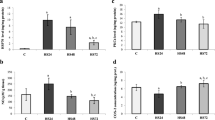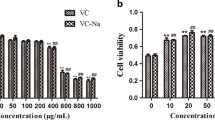Abstract
Dosed adaptation to environmental factors is an efficient non-drug means for increasing the resistance of organs or the body as a whole. We demonstrated earlier that nitric oxide (NO) plays an important role in adaptive defense of the organism, in particular due to activation of heat shock protein (HSP) synthesis. A key question remained open—to what extent the formation of adaptive defense depends on central mechanisms and to what extent on the intracellular mechanisms immediately responding to the adapting factor, and whether the NO-dependent activation of HSP synthesis plays a role in adaptation of isolated cells. In the present study we looked into the possibility of producing a protective effect of adaptation to heat in cell culture. A 6-day adaptation to heat limited to 17% the decrease in metabolic activity induced by heat shock in H9c2 cardiomyoblasts. The development of adaptation was associated with increased NO production. Treatment of cells with the inhibitor of NO synthase L-NNA (100 μM) prevented the development of adaptive protection. Adaptation of cell culture enhanced synthesis of HSP70 but not HSP27. Blockade of HSP70 synthesis with quercetin (50 μM) left unchanged the protective effect of adaptation. Inhibition of NO synthesis restricted the adaptation-induced HSP70 synthesis. Therefore, the formation of adaptation at the cell level may result from a direct action of an environmental factor without participation of neurohumoral factors. Such adaptation involves NO-dependent mechanisms divorced from the activation of HSP70 synthesis.
Similar content being viewed by others
REFERENCES
Bolli, R. (2000) Circ. Res., 87, 972-983.
Murry, C. E., Jennings, R. B., and Reimer, K. A. (1986) Circulation, 74, 1124-1136.
Currie, R. W., Karmazyn, M., Kloc, M., and Mailer, K. (1988) Circ. Res., 63, 543-549.
Pelham, H. R. B. (1986) Cell, 46, 517-528.
Hightower, L. E. (1991) Cell, 66, 191-197.
Latchman, D. S. (2001) Cardiovasc. Res., 51, 637-646.
Hartl, F. (1996) Nature, 381, 571-579.
Heneka, M. T., Sharp, A., Klockgether, T., Gavrilyuk, V., and Feinstein, D. L. (2000) J. Cerebr. Blood Flow Metab., 20, 800-811.
Beere, H. M., and Green, D. R. (2001) Trends Cell. Biol., 11, 6-10.
Raeburn, C. D., Cleveland, J. C., Jr., Zimmerman, M. A., and Harken, A. H. (2001) Arch. Surg., 136, 1263-1266.
Meerson, F. Z. (1984) Adaptation, Stress and Prophylaxis, Springer Verlag, Berlin.
Meerson, F. Z., Belkina, L. M., and Dyussenov, S. S. (1986) Kardiologiya, No. 8, 19-24.
Meerson, F. Z., Belkina, L. M., and Dyussenov, S. S. (1986) Byull. Eksp. Biol. Med., No. 11, 512-515.
Meerson, F. Z., and Malyshev, I. Yu. (1993) Phenomenon of Adaptive Stabilization of Structures and Protection of the Heart [in Russian], Nauka, Moscow.
Malyshev, I. Yu., and Manukhina, E. B. (1998) Biochemistry (Moscow), 63, 840-853.
Kim, Y.-M., Bombeck, C. A., and Billiar, T. R. (1999) Circ. Res., 84, 253-256.
Siow, R. C. M., Sato, H., and Mann, G. E. (1999) Cardiovasc. Res., 41, 385-394.
Lamas, S., Perez-Sala, D., and Moncada, S. (1998) Trends Pharmacol. Sci., 19, 436-438.
Du Toit, E. F., McCarthy, J., Miyashiro, J., Opie, L. H., and Brunner, F. (1998) Br. J. Pharmacol., 123, 1159-1167.
Malyshev, I. Yu., Bayda, L. A., Trifonov, A. I., Larionov, N. P., Kubrina, L. D., Mikoyan, V. D., Vanin, A. F., and Manukhina, E. B. (2000) Physiol. Res., 49, 99-105.
Stein, B., Frank, P., Schmitz, W., Scholz, H., and Thoenes, M. (1996) J. Mol. Cell Cardiol., 28, 1631-1639.
Hosokawa, N., Hirayoshi, K., Kudo, H., Takechi, H., Aoike, A., Kawai, K., and Nagata, K. (1992) Mol. Cell. Biol., 12, 3490-3498.
Wu, B. Y., and Yu, A. C. (2000) J. Neurosci. Res., 62, 730-736.
Mosmann, T. (1983) J. Immunol. Meth., 65, 55-63.
Gomez, L. A., Alekseev, A. E., Aleksandrova, L. A., Brady, P. A., and Terzic, A. (1997) J. Mol. Cell. Cardiol., 29, 1255-1266.
Rossig, L., Hoffmann, J., Hugel, B., Mallat, Z., Haase, A., Freyssinet, J. M., Tedgui, A., Aicher, A., Zeiher, A. M., and Dimmeler, S. (2001) Circulation, 104, 2182-2187.
Gabryel, B., Adamek, M., and Trzeciak, H. I. (2001) Neurotoxicology, 22, 455-465.
Kong, J. Y., and Rabkin, S. W. (2000) Biochim. Biophys. Acta, 1485, 45-55.
Zeng, H., Spencer, N. Y., and Hogg, N. (2001) Am. J. Physiol. Heart Circ. Phys. Vol., 281, H432-H439.
Chae, H. J., Kim, H. R., Kwak, Y. G., Ko, J. K., Joo, C. U., and Chae, S. W. (2001) Immunopharmacol. Immuno-toxicol., 23, 187-204.
Murphy, M. P. (1999) Biochim. Biophys. Acta, 1411, 401-414.
Kim, Y.-M., de Vera, M. E., Watkins, S. C., and Billiar, T. R. (1997) J. Biol. Chem., 272, 1402-1411.
Narberhaus, F. (2002) Microbiol. Mol. Biol. Rev., 66, 64-93.
Moseley, P. L. (1997) J. Appl. Physiol., 83, 1413-1417.
Wiegant, F. A. C., Souren, J. E. M., van Rijn, J., and van Wijk, R. (1994) Toxicology, 94, 143-159.
Samali, A., Holmberg, C. I., Sistonen, L., and Orrenius, S. (1999) FEBS Lett., 461, 306-310.
Author information
Authors and Affiliations
Rights and permissions
About this article
Cite this article
Monastyrskaya, E.A., Andreeva, L.V., Duchen, M.R. et al. Adaptation to Heat of Cardiomyoblasts in Culture Protects Them against Heat Shock: Role of Nitric Oxide and Heat Shock Proteins. Biochemistry (Moscow) 68, 816–821 (2003). https://doi.org/10.1023/A:1025047303523
Issue Date:
DOI: https://doi.org/10.1023/A:1025047303523




